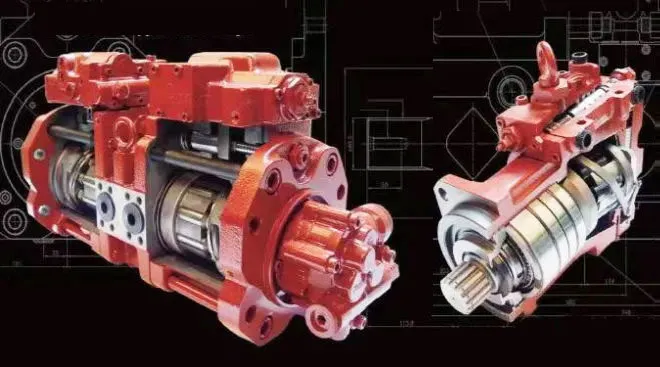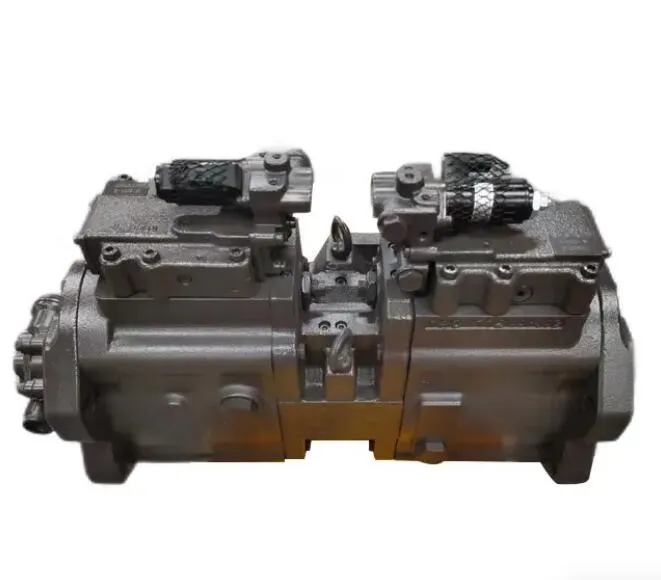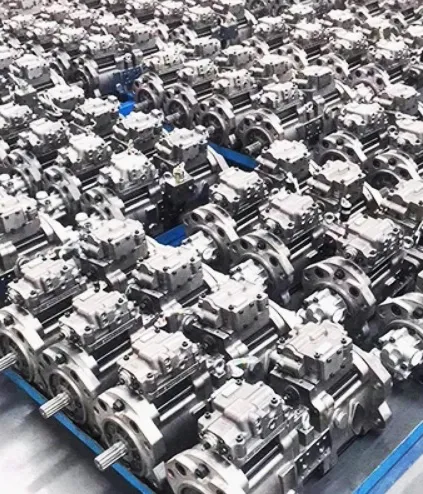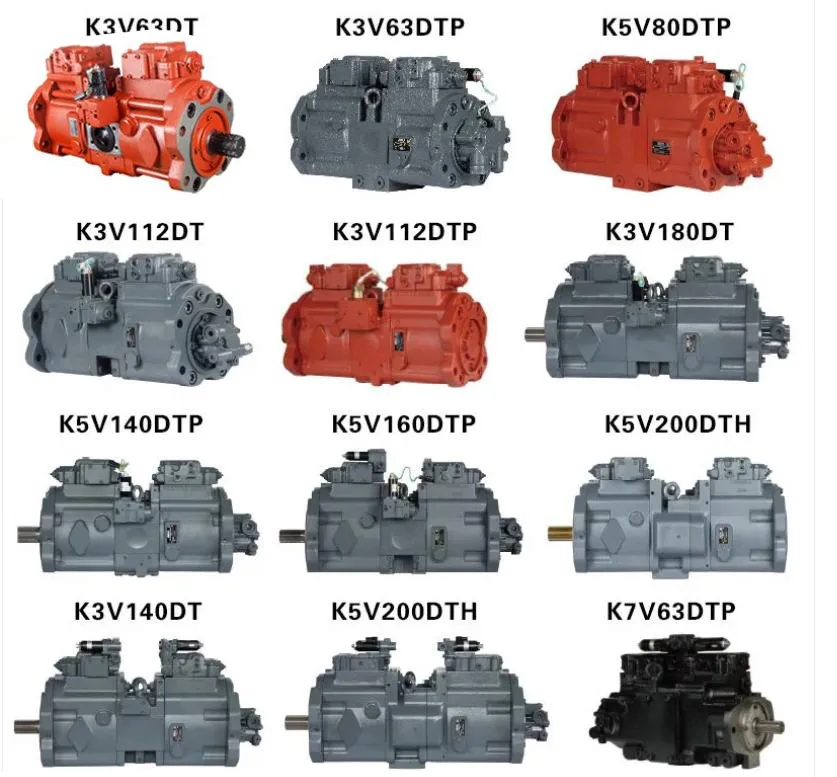
Excavator hydraulic systems are complex and essential components of these powerful machines. They provide the force and control necessary for excavators to perform their various tasks, from digging and trenching to lifting and moving heavy objects. Understanding the basics of excavator hydraulic systems is crucial for operators and maintenance personnel alike.

The heart of an excavator’s hydraulic system is the hydraulic pump. This pump converts mechanical energy from the engine into hydraulic pressure, which is then distributed throughout the system. The pressure is controlled by a series of valves, which regulate the flow of hydraulic fluid to the various actuators.
Actuators are the components that convert hydraulic pressure into mechanical motion. In excavators, actuators are used to power the boom, arm, bucket, and other attachments. The type of actuator used depends on the specific application. For example, linear actuators are used for straight-line movements, while rotary actuators are used for rotational movements.
Hydraulic fluid is the lifeblood of an excavator’s hydraulic system. It transmits pressure and lubricates the components. The fluid must be clean and free of contaminants to ensure proper system operation. Regular maintenance, including fluid changes and filter replacements, is essential to prevent system failures.
Excavator hydraulic systems are designed to provide precise control and power. However, they can be dangerous if not operated or maintained properly. Operators must be trained on the safe operation of excavators, and maintenance personnel must have a thorough understanding of the hydraulic system.
In addition to the basic components described above, excavator hydraulic systems may also include other features, such as:
Accumulators: These devices store hydraulic pressure and release it when needed, providing additional power for demanding tasks.
Relief valves: These valves protect the system from excessive pressure by diverting excess fluid back to the reservoir.
Filters: These components remove contaminants from the hydraulic fluid, ensuring system cleanliness.
Understanding the basics of excavator hydraulic systems is essential for safe and efficient operation. By familiarizing themselves with the components and principles of these systems, operators and maintenance personnel can ensure that excavators perform at their best and avoid costly breakdowns.
Hydraulic pumps are the heart of an excavator’s hydraulic system, providing the power to operate its various functions. Among the different types of hydraulic pumps used in excavators, axial piston pumps stand out for their efficiency and versatility.
Axial piston pumps feature a rotating cylinder block with multiple pistons arranged in a circular pattern. As the cylinder block rotates, the pistons reciprocate within their bores, creating a pumping action. This design allows for high-pressure output and efficient operation.
One of the key advantages of axial piston pumps is their ability to handle high pressures. They can generate pressures up to 5,000 psi (345 bar), making them suitable for demanding applications such as excavation and heavy lifting. Additionally, axial piston pumps offer a wide range of flow rates, allowing them to adapt to different excavator requirements.
Another advantage of axial piston pumps is their versatility. They can be configured with various control mechanisms, including pressure compensators and load-sensing systems. This allows them to adjust their output to match the specific demands of the excavator’s hydraulic system.
Axial piston pumps are also known for their durability and reliability. They are typically constructed from high-strength materials and feature precision-engineered components. This ensures a long service life and minimizes the risk of breakdowns.
However, axial piston pumps can be more complex and expensive than other types of hydraulic pumps. They also require regular maintenance to ensure optimal performance.
In summary, axial piston pumps offer a combination of efficiency, versatility, and durability, making them an ideal choice for excavators. Their ability to handle high pressures and flow rates, along with their adaptability to different control systems, makes them well-suited for the demanding requirements of excavation and heavy lifting applications.
Hydraulic pumps are the heart of an excavator’s hydraulic system, providing the power to operate its various functions. Among the different types of hydraulic pumps used in excavators, gear pumps stand out for their simplicity and durability.
Gear pumps consist of two intermeshing gears, typically made of hardened steel or cast iron. As the gears rotate, they create a vacuum that draws hydraulic fluid into the pump. The fluid is then trapped between the gears and the pump housing, and as the gears continue to rotate, it is forced out of the pump at high pressure.
The simplicity of gear pumps makes them relatively easy to manufacture and maintain. They are also highly durable, as the gears are designed to withstand high loads and wear. Additionally, gear pumps are self-priming, meaning they can draw fluid from a reservoir without the need for an external priming device.
However, gear pumps have some limitations. They are not as efficient as other types of pumps, such as vane pumps or piston pumps, and they can generate noise and vibration. Additionally, gear pumps are not suitable for applications where high flow rates or pressures are required.
Despite these limitations, gear pumps remain a popular choice for excavators due to their simplicity, durability, and self-priming capabilities. They are particularly well-suited for applications where reliability and ease of maintenance are important considerations.
In addition to gear pumps, other types of hydraulic pumps used in excavators include vane pumps, piston pumps, and axial piston pumps. Each type of pump has its own advantages and disadvantages, and the choice of pump depends on the specific requirements of the application.
Vane pumps are known for their high efficiency and low noise levels, while piston pumps offer high pressures and flow rates. Axial piston pumps are the most efficient type of hydraulic pump, but they are also the most complex and expensive.
The selection of the appropriate hydraulic pump for an excavator is crucial for ensuring optimal performance and reliability. Factors to consider include the required flow rate, pressure, efficiency, noise level, and durability. By carefully evaluating these factors, engineers can choose the best hydraulic pump for their specific application.

유압 펌프 are essential components of excavators, providing the power to operate the machine’s hydraulic systems. Among the various types of hydraulic pumps used in excavators, vane pumps stand out for their compactness and high-pressure capabilities.
Vane pumps consist of a rotor with radial slots that house vanes. As the rotor rotates, the vanes slide in and out of the slots, creating variable-volume chambers. Hydraulic fluid enters the pump through the inlet port and is trapped in these chambers. As the rotor continues to rotate, the fluid is forced out through the outlet port.
The compactness of vane pumps makes them ideal for excavators with limited space constraints. Their small size allows for easy installation and maintenance, even in tight compartments. Additionally, vane pumps are known for their high-pressure capabilities, making them suitable for applications requiring significant hydraulic force.
Vane pumps offer several advantages over other types of hydraulic pumps. They are relatively inexpensive to manufacture, making them a cost-effective option. They also have a simple design, which contributes to their reliability and ease of maintenance. Furthermore, vane pumps can operate at high speeds, providing a high flow rate of hydraulic fluid.
However, vane pumps also have some limitations. They are not as efficient as other types of pumps, such as piston pumps, and can generate more noise during operation. Additionally, vane pumps are susceptible to wear and tear, especially in high-pressure applications.
Despite these limitations, vane pumps remain a popular choice for excavators due to their compactness, high-pressure capabilities, and cost-effectiveness. They are particularly well-suited for applications where space is limited and high hydraulic force is required.
In conclusion, vane pumps are a valuable type of hydraulic pump for excavators. Their compact size, high-pressure capabilities, and cost-effectiveness make them an ideal choice for a wide range of applications. While they may have some limitations, vane pumps continue to be a reliable and efficient solution for powering the hydraulic systems of excavators.
Excavator hydraulic systems are complex and essential components that power the machine’s movements and functions. Understanding their operation is crucial for troubleshooting common issues and ensuring optimal performance.
The hydraulic system consists of a hydraulic pump, control valves, cylinders, and hoses. The pump generates hydraulic pressure, which is then directed to the control valves. These valves regulate the flow of hydraulic fluid to the cylinders, which in turn extend or retract to move the excavator’s components.
One common issue is hydraulic leaks. These can occur due to damaged hoses, loose fittings, or worn seals. Leaks can lead to reduced hydraulic pressure and impaired machine performance. To address leaks, inspect the system for any visible damage and tighten loose fittings. If necessary, replace damaged hoses or seals.
Another issue is overheating. Excessive heat can damage hydraulic components and reduce system efficiency. Overheating can be caused by overworking the excavator, clogged filters, or insufficient cooling. To prevent overheating, ensure the excavator is operated within its capacity, regularly clean filters, and check the cooling system for any blockages.
Hydraulic contamination is another common problem. Dirt, debris, or water can enter the system through damaged hoses or seals. Contamination can cause wear and tear on components, leading to reduced performance and premature failure. To prevent contamination, use clean hydraulic fluid and regularly inspect the system for any signs of ingress.
Hydraulic pressure issues can also arise. Low pressure can result from a faulty pump, clogged filters, or leaks. High pressure, on the other hand, can be caused by a malfunctioning relief valve or excessive load on the system. To address pressure issues, check the pump, filters, and relief valve. Adjust the load on the excavator as necessary.
Finally, electrical issues can affect the hydraulic system. Faulty sensors, wiring, or controllers can disrupt the flow of hydraulic fluid or cause the system to malfunction. To troubleshoot electrical issues, inspect the wiring harness for any damage or loose connections. Check the sensors and controllers for proper operation.
By understanding the operation of excavator hydraulic systems and troubleshooting common issues, operators can ensure optimal performance and extend the life of their machines. Regular maintenance, prompt repairs, and proper operation are essential for maintaining a reliable and efficient hydraulic system.
Hydraulic pumps play a crucial role in the performance of excavators, providing the power to operate various functions such as digging, lifting, and swinging. Optimizing pump efficiency is essential to maximize excavator productivity and reduce operating costs.
Key Factors Affecting Pump Efficiency
Several factors influence hydraulic pump efficiency, including:
Pump design:The type of pump (e.g., gear, vane, piston) and its design features (e.g., number of teeth, vane geometry) impact efficiency.
Operating conditions:Pressure, flow rate, and temperature affect pump efficiency. Operating within the recommended range is crucial.
Fluid properties:The viscosity and cleanliness of the hydraulic fluid influence pump performance.
System design:The overall hydraulic system design, including piping, valves, and filters, can affect pump efficiency.
Measurement Techniques
Measuring pump efficiency involves determining the ratio of hydraulic power output to mechanical power input. Common techniques include:
Volumetric efficiency: Measures the ratio of actual flow rate to theoretical flow rate.
Mechanical efficiency: Measures the ratio of hydraulic power output to mechanical power input.
Overall efficiency: Combines volumetric and mechanical efficiency to provide a comprehensive measure of pump performance.
Optimizing Pump Efficiency

Select the right pump:Choose a pump that matches the excavator’s specific requirements and operating conditions.
Maintain proper operating conditions:Ensure that the pump operates within the recommended pressure, flow rate, and temperature ranges.
Use high-quality hydraulic fluid:Maintain clean and properly lubricated fluid to minimize friction and wear.
Optimize system design: Minimize pressure drops and flow restrictions in the hydraulic system.
Regular maintenance: Perform regular inspections, maintenance, and repairs to keep the pump in optimal condition.
Benefits of Optimized Pump Efficiency
Increased productivity:** Improved pump efficiency translates into increased hydraulic power, enabling faster and more efficient operation.
Reduced operating costs:** Lower energy consumption and reduced maintenance costs contribute to overall cost savings.
Extended pump life:** Proper maintenance and optimization extend the lifespan of the pump, reducing downtime and replacement costs.
Improved environmental performance:** Reduced energy consumption and fluid leakage contribute to a more environmentally friendly operation.
By understanding the key factors affecting pump efficiency and implementing optimization strategies, excavator operators can maximize the performance and efficiency of their machines, leading to increased productivity, reduced costs, and improved environmental sustainability.
Optimizing Excavator Hydraulic Pump Efficiency for Maximum Performance
Hydraulic pumps play a crucial role in the performance of excavators, providing the power to operate various functions such as lifting, digging, and swinging. Maximizing the efficiency of these pumps is essential for achieving optimal excavator performance and reducing operating costs. Here are some practical strategies to enhance hydraulic pump efficiency:
Proper Maintenance: Regular maintenance is paramount for maintaining pump efficiency. Adhering to the manufacturer’s recommended maintenance schedule, including timely oil changes and filter replacements, helps prevent contamination and wear, ensuring optimal pump operation.
Oil Selection: Choosing the right hydraulic oil is vital. Using high-quality oil with the appropriate viscosity and additives reduces friction and heat generation, improving pump efficiency. Synthetic oils often offer superior performance and extended service intervals compared to mineral oils.
System Pressure Optimization: Maintaining the correct system pressure is crucial. Excessive pressure can lead to increased power consumption and premature component failure, while insufficient pressure can compromise pump performance. Regularly monitoring and adjusting system pressure to the manufacturer’s specifications ensures optimal pump operation.
Load Management: Avoiding overloading the pump is essential. Operating the excavator within its recommended load capacity prevents excessive strain on the pump, reducing wear and tear and extending its lifespan.
Component Inspection: Periodically inspecting hydraulic components, including hoses, fittings, and valves, helps identify potential leaks or blockages. Promptly addressing these issues minimizes pressure losses and maintains pump efficiency.
Temperature Control: Excessive heat can adversely affect pump performance. Installing temperature sensors and monitoring system temperatures allows for timely intervention to prevent overheating. Implementing cooling measures, such as heat exchangers or additional cooling fans, can help maintain optimal operating temperatures.
Filtration: Effective filtration is crucial for removing contaminants from the hydraulic fluid. Using high-quality filters with the appropriate micron rating ensures that dirt and debris are effectively removed, preventing pump damage and maintaining efficiency.
By implementing these strategies, excavator operators can optimize hydraulic pump efficiency, resulting in improved performance, reduced operating costs, and extended equipment lifespan. Regular monitoring, proactive maintenance, and attention to detail are key to maximizing the efficiency of these critical components and ensuring the smooth and productive operation of excavators.